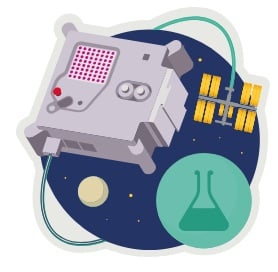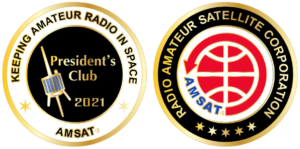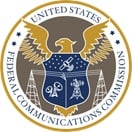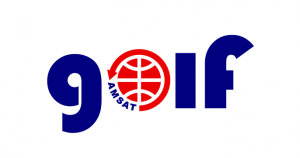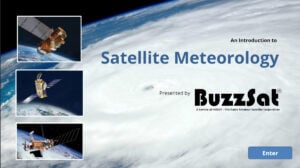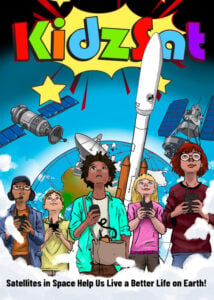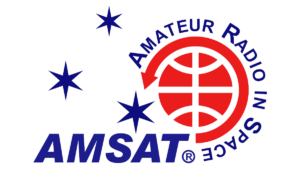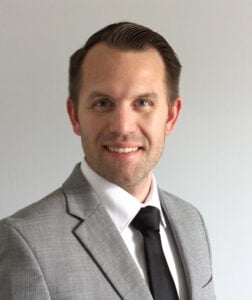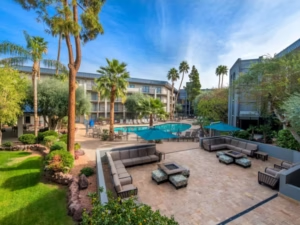In this edition:
- CubeSatSim Kits Now Available
- Youth on the Air Camp 2026 Applications Open
- AMSAT Youth Initiative: “Satellites and Climate Change” Course Now Online
- United Nations Office for Outer Space Affairs: Sustainable Development Goals
- Launch Teams Practiced Artemis 2 Countdown
- Changes to AMSAT-NA TLE Distribution for December 26, 2025
- ARISS NEWS
- AMSAT Ambassador Activities
- Satellite Shorts From All Over
The AMSAT(R) News Service bulletins are a free, weekly news and information service of AMSAT, the Radio Amateur Satellite Corporation. ANS publishes news related to Amateur Radio in Space including reports on the activities of a worldwide group of Amateur Radio operators who share an active interest in designing, building, launching and communicating through analog and digital Amateur Radio satellites.
The news feed on http://www.amsat.org publishes news of Amateur Radio in Space as soon as our volunteers can post it.
Please send any amateur satellite news or reports to: ans-editor [at] amsat.org .
Sign up for free e-mail delivery of the AMSAT News Service Bulletins via the ANS List. Join this list at: https://mailman.amsat.org/postorius/lists/ans.amsat.org/
CubeSatSim Kits Now Available
CubeSatSim is a low-cost satellite emulator that runs on solar panels and batteries, transmits UHF radio telemetry, has a 3D printed frame, and can be extended by additional sensors and modules. It is perfect for the classroom or for public demonstrations.
Ten kits are available immediately with an additional ten kits available next week. The cost for a complete no-solder kit is $550. The price includes postage to any U.S. address. Sorry, CubeSatSims can be mailed only to U.S. addresses. Kits can be ordered at the AMSAT Store.
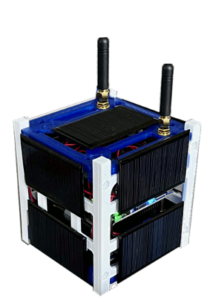
This kit allows you to build a CubeSat Simulator with no soldering, just assembly. This item contains:
- All three PCBs (Main, Solar, and Battery Boards) fully assembled and tested with all components and sensors soldered in
- Raspberry Pi Zero 2 WH with a Pi Camera and fully programmed micro-SD card and a fully programmed Raspberry Pi Pico WH and USB sound card
- AMSAT logo Remove Before Flight tag switch
- Four-piece 3D printed frame and nylon screws and nuts, ready for you to assemble with included mini screwdriver
- Metal standoffs, stacking headers, and JST jumpers ready for you to stack the PCBs and the Pi Zero 2 into the board stack
- 10 solar panels with JST connectors soldered on, and double stick mounting tape, ready for you to mount them using the tape on the frame
- Two 6? SMA coax cables and two SMA antennas for you to connect to the STEM Payload board and the frame
- Instruction sheet with parts inventory and link to the online instructions.

The approximate time for you to complete the kit by assembling the board stack and frame is about an hour and a half. You will need scissors, and an included mini Phillips screw driver.
The current v2.0 CubeSatSim has some improvements over the v1.2 version, including an FM transceiver, Raspberry Pi Pico micro controller, and RF command and control. You can also modify it to fly as a 500mW high altitude balloon payload.
For those who like to solder the components and 3D print their own frame, we also have the v2.0 blank PCB sets available at the AMSAT Store for $35: https://www.amsat.org/product/amsat-cubesatsim-pcb/ You will need to purchase the rest of the parts from Digikey and Amazon for approximately $400 using the Bill of Materials https://CubeSatSim.org/bom .
Resources:
- Kit instructions: https://cubesatsim.org/kit
- Kit videos: https://cubesatsim.org/kit-videos
- Discussion Forum on CubeSatSim on GitHub: https://github.com/alanbjohnston/CubeSatSim/discussions
- Operating Quick Start Guide: https://cubesatsim.org/qsg
For additional information about the CubeSatSim, if you would like multiple kits for an educational event or if you would like to borrow a loaner CubeSat Simulator for an event, contact Alan Johnston, KU2Y, AMSAT VP-Educational Relations via email ku2y at arrl dot net.
[ANS thanks Alan Johnston, KU2Y, AMSAT VP-Educational Relations, for the above information.]
Youth on the Air Camp 2026 Applications Open
Applications are now being accepted for campers interested in attending Youth on the Air Camp. Licensed amateur radio operators ages 15 through 25 who want to attend are encouraged to apply online at YouthOnTheAir.org. Applications will continue to be accepted through May 1. The camp is scheduled to take place June 14-19, 2026, in Huntsville, Alabama, United States of America.
For the first time, YOTA Camp will have a theme for the week: Space.
For the best chance at being selected, applications should be submitted by 2359Z on January 15, 2026. Campers will be selected by the working group and notified by February 1.

The application process is FREE. A $100 USD deposit is required upon acceptance. Should a potential camper be unable to pay the $100 deposit, he or she may apply for a scholarship or waiver. Campers are also responsible for their own arrival and departure transportation to the camp location. Travel assistance may also be available.
Up to 50 campers will be accepted. Priority will be given to first-time attendees and youth residing outside of the USA. Only a limited number of returning attendees will be accepted and must serve as leaders during the camp. Leaders will be selected based on staffing needs to facilitate this year’s session choices.
Huntsville Amateur Radio Club is the local host for the 2026 camp.
For details about the camp, visit the camp web page at https://www.youthontheair.org .
[ANS thanks Camp Director Neil Rapp, WB9VPG, for the above information.]
Only 4 Days Left to Get Your 2025 Coin!
Celebrate the 40th Anniversary of Amateur Radio on Human Spaceflight
Help Support GOLF and FoxPlus.
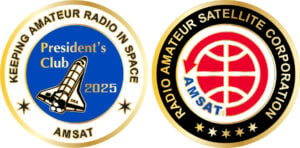
Annual memberships start at only $120
Join the AMSAT President’s Club today and help
Keep Amateur Radio in Space!
https://www.amsat.org/join-the-amsat-presidents-club/
AMSAT Youth Initiative: “Satellites and Climate Change” Course Now Online
The beta release of “Satellites and Climate Change” is now available online. This course is the second online course published as part of the AMSAT Youth Initiative’s series “How Satellites in Space Help Us Live a Better Life Here on Earth.”
The course was written by Eric Sonnenwald, N2XSE. Eric, a retired science teacher in Lake Hopatcong, New Jersey, is a graduate of Montclair State University with an M.S. in Geosciences and the former Science Curriculum Coordinator for Hardyston Middle School. In order to expedite the development of the courses and keep costs low, one of Eric’s most challenging tasks in creating the lessons is sourcing copyright-free graphics and related resources. Fortunately there is a relatively abundant pool of free materials available on government and college websites from which to draw.
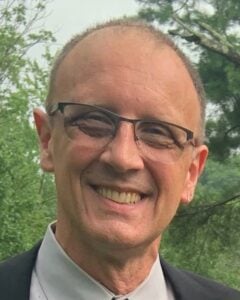
From Eric’s content, other AMSAT volunteers use specialized software to format the content into an online presentation.
The “Satellite and Climate Change” course follows the “Introduction to Satellite Meteorology” course introduced at Hamvention 2025. Several improvements have been added to the lesson format including the ability to zoom in and enlarge complex graphics shown in the screens. This is an important addition since students often use smartphones or tablets with much smaller screens that desktop or laptop computers

The third course, “Satellites and Pollution Control” is scheduled for launch within the next week or two, followed by “Satellites and Preservation of Natural Resources” in January. In all, fourteen courses are scheduled for publication by the end of 2026.
Frank Karnauskas, N1UW, AMSAT Vice President-Development and creator of the Youth Initiative explains, “Our approach to getting youth interested in satellites and amateur radio is to attract their attention and participation in topics of current events and widespread interest. We explain how satellites are an integral component of almost every facet of modern living and from there introduce the concept of critical information provided by satellites, then telemetry, and communications. We provide access to experiences with satellite telemetry via amateur radio satellite ground stations to access ARISS packet and voice stations aboard the International Space Station as well as other amateur radio satellites. Essentially, we try to ‘set the hook’ by giving students access to SWL experiences in the same way many of us got our start in amateur radio and with hands-on opportunity to download and analyze actual telemetry.
“A unique concept in designing the Youth Initiative program is that it is a community-based program available to all youth, through their own self-interest, though home-schooling and through programs such as Scouting, 4H or community based programs for youth with special needs. Teachers are welcome to incorporate the materials into their curriculum where their school boards allow them to do so. But, the key here is that school participation is not needed for parents or other leaders to utilize our materials.”
Karnauskas further explains that all materials are available online at no charge to every and all persons interested in furthering the interest of students in science, technology, engineering, art and mathematics.
AMSAT is grateful to Amateur Radio Digital Communications for a generous grant to cover the cost of software licenses for online development and for supplemental technical artwork.
Readers can preview the online courses at https://www.BuzzSat.com .
[ANS thanks AMSAT for the above information.]
Need new satellite antennas?
Purchase M2 LEO-Packs from the AMSAT Store.
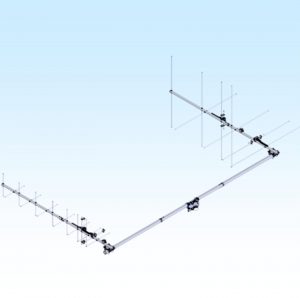
When you purchase through AMSAT, a portion of the proceeds goes towards
Keeping Amateur Radio in Space.
https://amsat.org/product-category/hardware/
United Nations Office for Outer Space Affairs: Sustainable Development Goals
The United Nations Office for Outer Space Affairs works to promote international cooperation in the peaceful use and exploration of space, and in the utilization of space science and technology for sustainable economic and social development. Space technologies have an impact on almost all aspects of development.
Despite the growing global economy and the technological progress observed in the past decades, there are still many societal challenges that need to be overcome to enhance human development. The United Nations, involving more than 190 Member States, has developed the 2030 Agenda for Sustainable Development in order to address these challenges in the form of 17 Sustainable Development Goals (SDGs).
- Goal 1. End poverty in all its forms everywhere
- Goal 2. End hunger, achieve food security and improved nutrition and promote sustainable agriculture
- Goal 3. Ensure healthy lives and promote well-being for all at all ages
- Goal 4. Ensure inclusive and equitable quality education and promote lifelong learning opportunities for all
- Goal 5. Achieve gender equality and empower all women and girls
- Goal 6. Ensure availability and sustainable management of water and sanitation for all
- Goal 7. Ensure access to affordable, reliable, sustainable and modern energy for all
- Goal 8. Promote sustained, inclusive and sustainable economic growth, full and productive employment and decent work for all
- Goal 9. Build resilient infrastructure, promote inclusive and sustainable industrialization and foster innovation
- Goal 10. Reduce inequality within and among countries
- Goal 11. Make cities and human settlements inclusive, safe, resilient and sustainable
- Goal 12. Ensure sustainable consumption and production patterns
- Goal 13. Take urgent action to combat climate change and its impacts*
- Goal 14. Conserve and sustainably use the oceans, seas and marine resources for sustainable development
- Goal 15. Protect, restore and promote sustainable use of terrestrial ecosystems, sustainably manage forests, combat desertification, and halt and reverse land degradation and halt biodiversity loss
- Goal 16. Promote peaceful and inclusive societies for sustainable development, provide access to justice for all and build effective, accountable and inclusive institutions at all levels
- Goal 17. Strengthen the means of implementation and revitalize the global partnership for sustainable development

The importance of the role of space applications such as Earth Observation (EO) and geolocation (provided by Global Navigation Satellite Systems known as GNSS) in supporting the achievement of the development goals is recognized by the United Nations.
To get an updated view on how space technologies and their synergies can help to tackle the challenges of the world’s increasing population and complex societies see https://www.unoosa.org/oosa/en/ourwork/space4sdgs/index.html .
[ANS thanks United Nations Office for Outer Space Affairs the above information.]
Want to fly the colors on your own grid expedition?
Get your AMSAT car flag and other neat stuff from our Zazzle store!
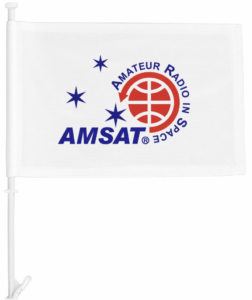
25% of the purchase price of each product goes towards
Keeping Amateur Radio in Space
https://www.zazzle.com/amsat_gear
Launch Teams Practiced Artemis 2 Countdown
In a prelude to the real deal, the four astronauts of the Artemis 2 mission boarded their Orion spacecraft inside the Vehicle Assembly Building at the Kennedy Space Center on Saturday afternoon, Dec. 20.
The three Americans and one Canadian participated in a launch day rehearsal referred to as the countdown demonstration test or CDDT. It was the first opportunity for everyone involved with the mission to be on hand and to go through the motions of the big day with the fully integrated rocket in the loop, instead of just data simulations. The test appeared to reach its conclusion with a cutoff of the simulated countdown at the T-29 seconds point at 5:51 p.m. EST (2251 UTC).
The rehearsal is already running at least a month behind schedule. It was scheduled for November 19 but NASA postponed that, eventually blaming “a blemish” on a thermal barrier surrounding the Orion crew access hatch which prevented its closure.
The test was rescheduled for Dec. 17, but that too was abruptly delayed without explanation.
The launch of Artemis 2 is currently slated for no earlier than February 6. NASA also says the launch will take place no later than April 2026.
Read the entire article at https://spaceflightnow.com/2025/12/21/astronauts-launch-teams-practice-artemis-2-countdown/ .
[ANS thanks Spaceflight Now for the above information.]
Changes to AMSAT-NA TLE Distribution for December 26, 2025
Two Line Elements or TLEs, often referred to as Keplerian elements or keps in the amateur community, are the inputs to the SGP4 standard mathematical model of spacecraft orbits used by most amateur tracking programs. Weekly updates are completely adequate for most amateur satellites. TLE bulletin files are updated daily in the first hour of the UTC day. New bulletin files will be posted immediately after reliable elements become available for new amateur satellites. More information may be found at https://www.amsat.org/keplerian-elements-resources/ .
CEVROSAT1 has been identified as object 66308.
[ANS thanks Joe Fitzgerald, KM1P, AMSAT Orbital Elements Manager for the above information.]
ARISS NEWS
Amateurs and others around the world may listen in on contacts between amateurs operating in schools and allowing students to interact with astronauts and cosmonauts aboard the International Space Station. The downlink frequency on which to listen is 145.800 MHz worldwide.
Upcoming Contacts
No contacts scheduled until after the first of the year.
The crossband repeater continues to be active (145.990 MHz up {PL 67} & 437.800 MHz down). If any crewmember is so inclined, all they have to do is pick up the microphone, raise the volume up, and talk on the crossband repeater. So give a listen, you just never know.

The packet system is also active (145.825 MHz up & down).
As always, if there is an EVA, a docking, or an undocking; the ARISS radios are turned off as part of the safety protocol.
Note, all times are approximate. It is recommended that you do your own orbital prediction or start listening about 10 minutes before the listed time.
The latest information on the operation mode can be found at https://www.ariss.org/current-status-of-iss-stations.html .
The latest list of frequencies in use can be found at https://www.ariss.org/contact-the-iss.html .
[ANS thanks Charlie Sufana, AJ9N, one of the ARISS operation team mentors for the above information.]
AMSAT Ambassador Activities
AMSAT Ambassadors provide presentations, demonstrate communicating through amateur satellites, and host information tables at club meetings, hamfests, conventions, maker faires, and other events.
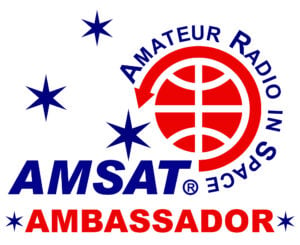
None currently scheduled.
[ANS thanks Bo Lowrey, W4FCL, Director – AMSAT Ambassador Program, for the above information.]
Satellite Shorts From All Over
+ They weren’t home for Christmas, but astronauts in space found their own way to make the season bright. They’ve even hung their space stockings by the airlock with care. Four astronauts on the International Space Station (ISS) sent their best Christmas wishes to Earth as they orbit our planet. NASA astronauts Mike Fincke, Zena Cardman and Chris Williams and Kimiya Yui of the Japan Aerospace Exploration Agency (JAXA) sent a video Christmas card home as they and three other crewmates spend the holidays 250 miles (400 kilometers) above Earth. “Greetings to planet Earth, all of our friends and family, from Expedition 74 aboard the International Space Station, flying high above,” said Fincke, who commands the Expedition 74 crew on the ISS. “Thinking of you during this holiday season.” Watch the heartwarming greeting and feel the season bright at https://tinyurl.com/ANS-362-Greetings . [ANS thanks space.com for the above information.]
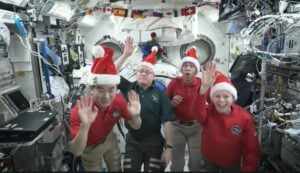
+ The global space sector is entering a phase of large-scale satellite constellations and expanded human lunar activity, driving a sharp increase in demand for access to orbit. Within the next two decades, the total mass launched to space is expected to reach several hundred thousand tons, with annual launch counts projected in the tens of thousands and continuing to grow. Launch providers therefore face simultaneous requirements for low cost, high flight rates, and airline-style reliability in space transportation systems. Reusable launch vehicles have reduced per-flight cost, but they do not yet deliver the launch tempo and reliability needed for this next phase of activity. A study in the Chinese Journal of Aeronautics argues that artificial intelligence applied across launch vehicle life cycles could address these remaining bottlenecks and become a disruptive technology following reusability in space transportation.The authors outline four main roles for AI in launch systems: agile test and launch preparation, high-reliability flight, rapid maintenance, and efficient safety operation and control. Learn more about the study at https://tinyurl.com/ANS-362-AI . [ANS thanks spacedaily.com for the above information.]
Join AMSAT today at https://launch.amsat.org/
In addition to regular membership, AMSAT offers membership to:
- Societies (a recognized group, clubs or organization).
- Primary and secondary school students are eligible for membership at no charge.
- Post-secondary school students enrolled in at least half time status shall be eligible for student membership for a maximum of 6 post-secondary years in this status.
- Memberships are available for annual and lifetime terms.
Contact info [at] amsat.org for additional membership information.
73 and remember to help Keep Amateur Radio in Space!
This week’s ANS Editor, Frank Karnauskas, N1UW.
f.karnauskas [at] amsat [dot] org
ANS is a service of AMSAT, the Radio Amateur Satellite Corporation, 712 H Street NE, Suite 1653, Washington, DC 20002.
AMSAT is a registered trademark of the Radio Amateur Satellite Corporation.

